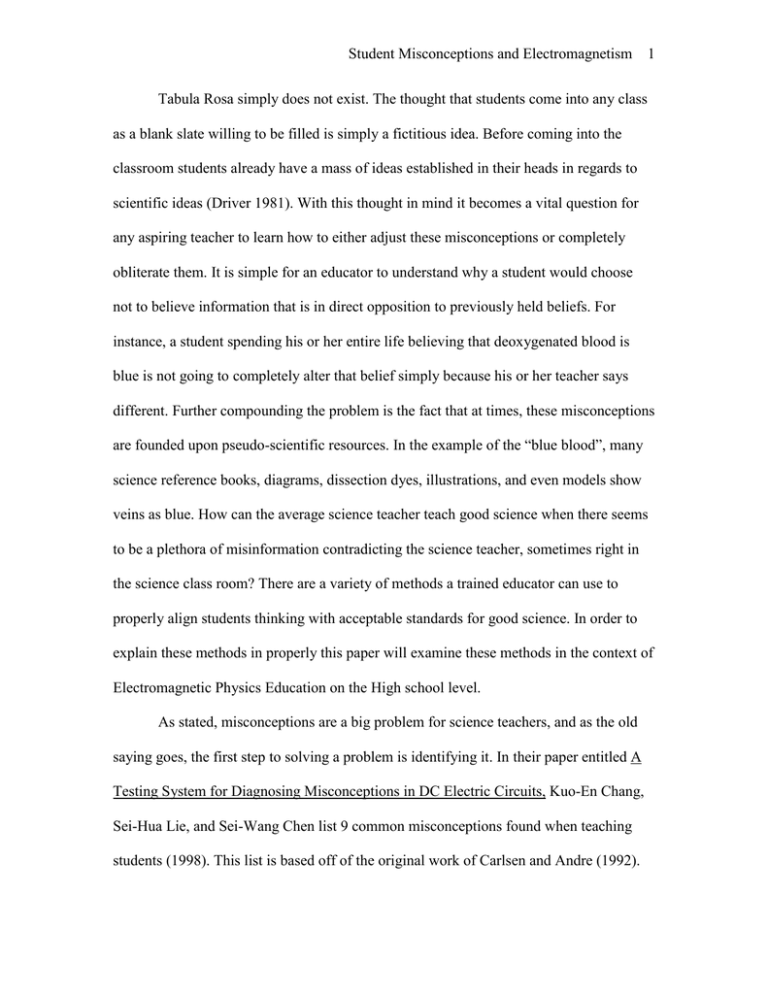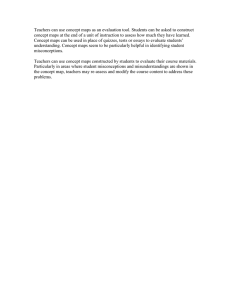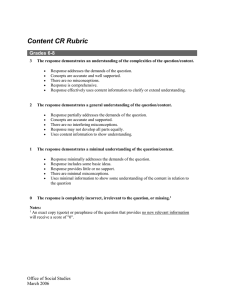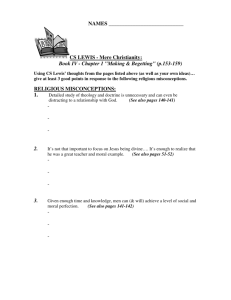example CSTME Grad Comp Exam
advertisement

Student Misconceptions and Electromagnetism 1 Tabula Rosa simply does not exist. The thought that students come into any class as a blank slate willing to be filled is simply a fictitious idea. Before coming into the classroom students already have a mass of ideas established in their heads in regards to scientific ideas (Driver 1981). With this thought in mind it becomes a vital question for any aspiring teacher to learn how to either adjust these misconceptions or completely obliterate them. It is simple for an educator to understand why a student would choose not to believe information that is in direct opposition to previously held beliefs. For instance, a student spending his or her entire life believing that deoxygenated blood is blue is not going to completely alter that belief simply because his or her teacher says different. Further compounding the problem is the fact that at times, these misconceptions are founded upon pseudo-scientific resources. In the example of the “blue blood”, many science reference books, diagrams, dissection dyes, illustrations, and even models show veins as blue. How can the average science teacher teach good science when there seems to be a plethora of misinformation contradicting the science teacher, sometimes right in the science class room? There are a variety of methods a trained educator can use to properly align students thinking with acceptable standards for good science. In order to explain these methods in properly this paper will examine these methods in the context of Electromagnetic Physics Education on the High school level. As stated, misconceptions are a big problem for science teachers, and as the old saying goes, the first step to solving a problem is identifying it. In their paper entitled A Testing System for Diagnosing Misconceptions in DC Electric Circuits, Kuo-En Chang, Sei-Hua Lie, and Sei-Wang Chen list 9 common misconceptions found when teaching students (1998). This list is based off of the original work of Carlsen and Andre (1992). Student Misconceptions and Electromagnetism 2 Chang, Lie, and Chen assign these misconceptions alpha-numeric codes in order to aid in diagnosing them in the classroom. These common misconceptions are: Current Existence (M1): the student believes that a single wire connection between a battery and a bulb will light the bulb. But the student does not know that the existence of current is associated with the condition of closed circuit. Voltage Existence (M2): a large number of pupils know that current only exists in a closed circuit, but they also believe it is same for the voltage. Weakening of Current (M3): the student believes that current flows around the circuit in one direction and becomes weakened as it goes so that the late circuit elements receive less current. Division of Current (M4): the student believes that current flows around the circuit in one direction and is shared equally by the circuit components, but is partially or completely used up in the circuit components. Battery Role (M5): the student believes that the battery is a “current reservoir” delivering a constant current whatever the circuit attached. Current in a Series Circuit (M6): many students believe that currents are the same in two contrasting circuits while ignoring the doubled resistance in the series circuit. Voltage in Series Circuit (M7): the student regards voltage the same as the current in the series circuit and guesses that all voltages crossing components in the series circuit are the same. Current in Parallel Circuit (M8): a large number of pupils believe that bulbs in parallel would shine less than a single identical bulb. Voltage in Parallel Circuit (M9): the student believes that branch voltages in the parallel circuit are different. (Chang, Lie, & Chen 1998 p. 205-206) After teaching this particular topic, I have noticed an additional misconception which will also be added to the list. Some students have issues realizing that even through the Voltage of parallel components in a circuit are equivalent, the Current on such components is not necessarily equal. This misconception will be called M10. Now that all possible problems are diagnosed, each misconception can be grouped in order to establish an appropriate place for addressing them in the curriculum. M1 and M2 (called Group 1) both deal with the understanding of concepts in closed or open circuits. M3 and M4 (called Group 2) deal with the distribution of current in a closed circuit. M5 (called Group 3) is dealing with a mechanical understanding of batteries and Student Misconceptions and Electromagnetism 3 how they function. M6 and M7 (called Group 4) are dealing with the specifics of series circuits. Finally, M8, M9, and M10 (called Group 5) are all dealing with issues involving parallel circuits. Next, the educator would develop a sequence of events to deal with the groups. It makes sense, from an educational point of view to first discuss the basics of a circuit, including the difference between a closed and open circuit, meaning that Group 1 misconceptions would be covered first. After this is covered, it only makes sense to continue the discussion on circuits from the point of view of closed circuits, meaning that Group 2 misconceptions should be addressed next. After basic circuits are covered, it is typical for an educator to move on to a discussion of series and then parallel circuits, so it is logical that Groups 4 and 5 would follow. Group 3 would be addressed finally since it is likely that while most of the labs conducted for Electromagnetism can be done by allowing the circuits to run for a relatively short amount of time to reduce battery ware, after an extended amount of labs at least one student in the class, possibly more, would ask why the batteries were slowly producing less and less current, which would lead right into a discussion and experimentation of Group 3 misconceptions. This provides for an accepted order of Grouped misconceptions of 1, 2, 4, 5, and 3, allowing an educator to fit the addressing of these misconceptions into an already established curriculum, while still ensuring students understand prerequisite information, instead of reworking the entire order of lessons, thereby cutting down on teacher strain and student stress. Once the educator has decided where to address misconceptions, it is important to identify which misconceptions need to be addressed. As discussed earlier it would be irresponsible for an educator to assume that these misconceptions do not exist, since most Student Misconceptions and Electromagnetism 4 sources indicate that students are not in a state of tabula rasa. On the other hand, not all students will have all misconceptions. For instance, the study done Anton E. Lawson, The acquisition of biological knowledge during childhood: Cognitive conflict or tabula rasa? , involving 3 children learning about Biology seems to indicate that these three subjects have very few, if any misconceptions or pre-established ideas about Biology (1987). Although some might question the validity of Lawson’s inferences in this study, it is reasonable to assume that some students may have learned good science in regards to certain topics, for various reasons. It may be that the student has a natural interest in the topic, or a student’s parents, guardian, or adult relative may work in that field of study, giving the student a unique insight not common among his or her peers. Whatever the case, it simply cannot be assumed that simply because a misconception exists, a student automatically has it. It would be irresponsible for an educator to make such an assumption and introduce these wrong ideas just for the sake of later clarifying them, endangering the quality of the students education and wasting precious class time. Since it is dangerous to make an assumption either way, an educator must be certain whether a student or group of students harbors a specific misconception. The easiest way to be certain is simply to pre-test the students. This can be done in a number of ways, however Teresa L. Hein in her publication, Using writing to confront student misconceptions in physics, indicates that having student write in a folder or a portfolio is one way to effectively pre-test for misconceptions. Additionally, including this method in the classroom would allow for an educator to incorporate NSES standards (National Research Council 1996) into the classroom by having students make observations as to Student Misconceptions and Electromagnetism 5 their findings in a lab journal while also introducing more formal writing into the science classroom, which is predominantly mathematical on the high school level. Once the students have written these journals, it would be a simple matter for an educator to chunk responses into one of the 10 pre-mentioned misconceptions while grading, allowing for a quick and effective diagnostic tool. A teacher could then simply compile a list of all misconceptions and see which ones his or her class has and which they do not. It then becomes a matter of addressing misconceptions that the students have. I have found in my teaching experience that all too often, misconceptions stack like a house of cards. In order to clear them away an educator has to get to the root or foundation of the inappropriate belief. This is where some traditional science educators might have a problem, since the best method that I have found to do this is to simply ask students why. Why to they believe what they do? Why are they so confident about what they believe? Eventually, I have found from experience that their answers will boil down to 1 of 3 things: 1) At some point the student had some real life experience which they rationalized incorrectly, had explained to them incorrectly, or only saw part of the picture of. 2) The student had something miss-explained to them without a direct experience. 3) The student had some indirect experience with the topic, such as a TV show, movie, or story of friends/family, which contradicts proper science understanding. Fortunately, no matter how a student has come to his or her understanding there is one "fix all" which works most effectively, and should be part a proper science classroom anyway, laboratory experiences. Students who see for themselves develop ownership of knowledge and as a result retain more information with more firm belief Student Misconceptions and Electromagnetism 6 (Savery & Duffy 2001). Simply put, a student is more likely to believe something if he or she makes the discovery as opposed to having a teacher simply say it. This extra advantage is vital when trying to break down misconceptions students have. All a skilled educator must do is find or develop labs or activities whose logical outcome flies directly in the face of the foundation of the misconception, and then guide the student with questions, not statements, to eventually uncover the underlying truth, thereby obliterating the misconception. In the Appendix, there is an effective assessment strategy for performing this task for misconceptions M1-M9. In order to demonstrate while explaining, consider M10. David is a student who believes that parallel circuits MUST have equal current in all components. According to Ohm’s Law, they do have equal Voltage and Voltage is directly proportional to Current, it would only go to reason, from David’s point of view, that Current too must be consistent across parallel components. The root of David’s misconceptions is a problem with understanding how a multi-variable system works, probably stemming from difficulty in Algebra. Although David’s reasoning is based on sound scientific principal, his final conclusion, as a result of his problem in Algebra, is counter productive to understanding the relationship between current ratios and resistance ratios in a parallel circuit. An Instructor at this stage could take one of two approaches. An Instructor could go back and focus specifically on the mathematical content explaining that when two independent variables are present we can’t necessarily make the direct comparison that David is making unless we hold one of the variable constant. The problem with this though is that, assuming that David’s Math teacher has already covered the needed material, David would have already gone over this point once, and for one Student Misconceptions and Electromagnetism 7 reason or another he simply didn’t get the concept the first time. It would be a waste of time to go back and repeat that same mistake. Instead, properly resolving this misconception would simply involving setting up a simple circuit board parallel or short wire circuit with a simple power source and 2 different resistors hooked up in parallel and asking David to take readings with both a Voltmeter and an Ammeter to see what happens with Current and Voltage across these two resistors to see what actually happens. David would then be left to reason, with the instructor asking guiding questions, about what he thinks about the current of two parallel components. Finally David should be asked why his current findings did not match up with his original hypothesis, allowing David not only the opportunity to understand more about circuits, but a bit more about math as well, solidifying the concept for David and effectively removing the misconception at its root, ensuring that it does not “grow” back over time. If this misconception is addressed in such a straight-forward manner, it may not be necessary for the instructor to belabor the point with excessive assessment, however there should at least be follow up questions such as, “What do you think would happen if we put a variable resistor in for one of these resistors?” A question like that tests if the student truly understands the concept, if the misconception has truly been resolved, and if the original “good science” knowledge is still maintained by the student (in this case the idea that voltage of parallel components is equal). Such a question could simply be asked in front of the class, or it could be given as a small homework assignment, or better yet, used as a topic of discussion for the students in their lab journal shortly after completing the lab designed to eliminate M10 in the first place. Once David has gone through these steps, not only will he no longer harbor this particular misconception, and be less likely Student Misconceptions and Electromagnetism 8 to support similar misconceptions from Group 5, but he would also retain the information much better since he now has ownership of it. In summation, although misconceptions in any area of science seem like an insurmountable opponent to deal with, by breaking them down systematically, grouping them, addressing them in an integrated fashion in the curriculum (if need be as indicated through pre-test), having the students resolve the conflict through teacher guided laboratory instruction augmented with guiding questions and finally laboratory style discussion journals for post assessment, these misconceptions, once properly resolved, can turn into pillars of scientific knowledge for the student. By allowing students the chance to resolve these misunderstanding instructors are not only imparting knowledge but cultivating a thirst for insight and further advancement, not only facilitating learning on the K-12 level, but creating an appropriate environment for a life long learner. Student Misconceptions and Electromagnetism APPENDIX Assessment Strategy 1. Concept to be addressed within the unit a. What is electricity? b. What is current? c. What is resistance? d. What is voltage? e. Why do some materials resist the flow of electrons? f. How do we calculate voltage? g. What is a circuit? h. How does a circuit function? i. How does one draw a circuit diagram? j. What is work in respects to a circuit? k. What is power? l. How can we calculate power of a circuit? m. How is power related to voltage, current, and resistance? n. What is a parallel circuit? i. How do you calculate its resistance? ii. How do you calculate its current iii. How do you calculate its voltage? o. What is a series circuit? i. How do you calculate its resistance? 9 Student Misconceptions and Electromagnetism 10 ii. How do you calculate its current iii. How do you calculate its voltage? p. What other non-electrical effects can circuits have? 2. Background Literature on students’ prior knowledge and misconceptions Diagnostic Assessment: Common Misconceptions: 9 common (Chang, Lie, & Chen 1998 p. 205-206) Addressing Misconceptions: a. M1 Student Misconceptions and Electromagnetism 11 i. Assessing if students have this particular misconception would involve a pretest on circuits where in all the students are given a power supply and a light bulb and ask to write down what other materials and in what amounts they need to illuminate the bulb. Then ask students to make a sketch of their set up (since at this point students would not yet be doing circuit diagrams however if a student does make a circuit diagram this would indicate that additional pretests were needed before beginning circuit diagrams). ii. Assessing if students still have these misconceptions after instruction would involve now having students looking at circuit diagrams (both complete and incomplete) to solve for current. Occasionally students would be given an incomplete circuit and asked what the current is in the circuit. Students who then say there is no current should be required to explain why. b. M2 i. After the post assessment for M1 is done, ask students if the power source in that incomplete circuit had a voltage. Why or why not? ii. As a post assessment, ask students if current causes voltage or if voltage causes current. Can one exist without the other? If so, which one is it? Why? This should be asked as a Do Now type of question after the lesson on voltage has been completed. The instructor can then collect this to see if this misconception has been addressed. c. M3 Student Misconceptions and Electromagnetism 12 i. For this misconception pre-test, students should be shown a circuit diagram for a quiz with 3 light bulbs set up in series with a power source. This quiz should be given the day after students have learned how to draw and interpret circuit diagrams. One of the questions on this quiz should be, "Which of these lights, if any, is brightest?" ii. As a post test, this same question should appear on the end unit test. d. M4: will also be addressed by assessment for M3. e. M5 i. No pretest is necessary for this since this will be discussed when the physics classes make their own batteries and hook them up to different circuits. In their lab write ups they will have to include information about how different circuits distribute current. ii. This will also be assessed in some of the questions on the unit final test as a post assessment f. M6: This will be addressed with M5. g. M7: This will be addressed with M5 h. M8: This will be addressed with M5 i. M9: This will be addressed with M5 3. Ongoing formative assessments: a. Pretest: After the first initial lesson into electricity, students will be assigned a KWL chart to begin. This is being done after the first lesson so that students Student Misconceptions and Electromagnetism 13 will all have at least one thing to put down for what they know about electricity. When we share these KWL charts, 1 of 3 things will happen i. All students will have great knowledge on one particular topic, in which case that topic can be covered less then it initially would have been ii. Few students will have great knowledge into one particular topic, in which case the information these students possess will be used as a spring board into getting the rest of the class involved. iii. No students will have a great knowledge into one particular topic. Although unlikely, this will simply mean that instruction will continue as previously planned. b. While continuing to have the group discussion/activity involving the tennis ball model, ask students to give a recap of what was covered the day before in their own words, using the tennis balls if needed. The entire class should group together to recap although there should be one or two students leading the discussion. Encourage students, if they have something to add or disagree with to bring up these ideas in a respectable manner. This will allow the instructor to quickly observe how exactly information is being integrated into students' established world schema. Once the students are all done, the instructor should ask questions such as, "Why did _____ refuse to pass electrons?" Student Misconceptions and Electromagnetism 14 c. Students will be required to add to this KWL chart every two days, so that each session students will have a chance to write something that they learned, and will have a new sub-topic to write about for the following class period. d. As the KWL chart progress one student each day will be asked to come up and add something to the class's total KWL chart started after the initial lesson on day 1. e. As students ask questions of have misconceptions we will pause class and add to the W section of the KWL. f. When students pose questions I will strive to adapt the next day of instruction to address those questions in an ongoing process. This will give the appearance that the class is driven by the students’ inquisition. 4. Summative assessment: My final assessment method for this unit will include 2 parts a. Part one will be a Concept Map students will have to construct themselves from their notes regarding Electricity. The Concept Map should resemble this: Student Misconceptions and Electromagnetism 15 b. Part 2 will involve calculating current, resistance, voltage, and power of a complex circuit I will ask them to draw from a description. They will also have to answer a series of questions. i. Description: An 110V power source is hooked up to 1 (20 Ω) resistor followed by a parallel set up with branches including 1(10 Ω), 1(30 Ω) and 2(20 Ω in series). The parallel branches then rejoin and there is then 1 (12 Ω) followed by 2 parallel (12 Ω) resistors. The circuit then completes itself. ii. Questions: 1. Draw the circuit. 2. Determine the total Resistance 3. Determine the Current at each resistor 4. Determine the Voltage at each resistor Student Misconceptions and Electromagnetism 16 5. If the circuit was not complete, what is the current in the circuit? 6. If the circuit was not complete, what is the voltage due to the power source? 7. If a 3 lights are placed before the first 20 Ω resistor, after first parallel section rejoins before the 12 Ω resistor, and right before the circuit is complete after the final parallel branch, which, if any, of the 3 lights will be brightest Work Cited: Student Misconceptions and Electromagnetism 17 Carlsen D. D., & Andre, T. (1992). Use of a microcomputer simulation and conceptual change text to overcome student preconceptions about electric circuits. Journal of Computer-Based Instruction, 19(4), 105-109 Chang, K., Liu, S., & Chen, S. (1998). A testing system for diagnosing misconceptions in DC electric circuits. Computers & Education, 31(2), 195-210. doi: 10.1016/S0360-1315(98)00030-X. Driver, Rosalind (1981). Pupils’ Alternative Frameworks in Science. International Journal of Science Education, 3 (1), 93-101. Retrieved May 01, 2009, from http://www.informaworld.com/10.1080/0140528810030109 Hein, T. L. (1999). Using writing to confront student misconceptions in physics. European Journal of Physics, 20(3), 137-141. Lawson, A. E. (1988). The acquisition of biological knowledge during childhood: Cognitive conflict or tabula rasa? Journal of Research in Science Teaching, 25(3), 185-199. doi: 10.1002/tea.3660250304. National Research Council (1996). National Science Education Standards. Washington, DC: National Academy Press Savery, John R., & Duffy, Thomas M. (June, 2001) Problem Based Learning: An instructional model and its constructivists framework. Bloomington, Indiana: Indiana University: Center for Research on Learning and Technology.



